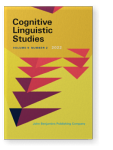Vol. 9:2 (2022) ► pp.297–322
Conceptual blending in entrenched Persian noun-noun nominal compounds
The case of āb-noun compounds
The current paper offers an analysis of a set of 27 entrenched endocentric, exocentric, and copulative āb (water)-noun nominal compounds in Persian with both right- and left-headed compounds, based on the network model of conceptual blending theory. Given that an emergent meaning is involved in endocentric and copulative compounds, the same as in exocentric compounds, the paper argues that all types of compounds can be insightfully defined as conceptual blends. However, the conceptual blending network model fails to show the distinct role of head and modifier in the overall meaning of compounds, on the one hand, and the qualifying difference in the extent of emergent meaning among various types of compound words, on the other hand. Our study also lends support to a correspondence between the continuum of integration networks and the continuum of figurativity in compounds.
Article outline
- 1.Introduction
- 2.Conceptual blending theory
- 3.Methodology
- 4.Analysis and discussion
- 4.1Simplex network
- 4.2Mirror network
- 4.3Single-scope network
- 4.4Double-scope network
- 5.Concluding remarks
- Notes
-
References
